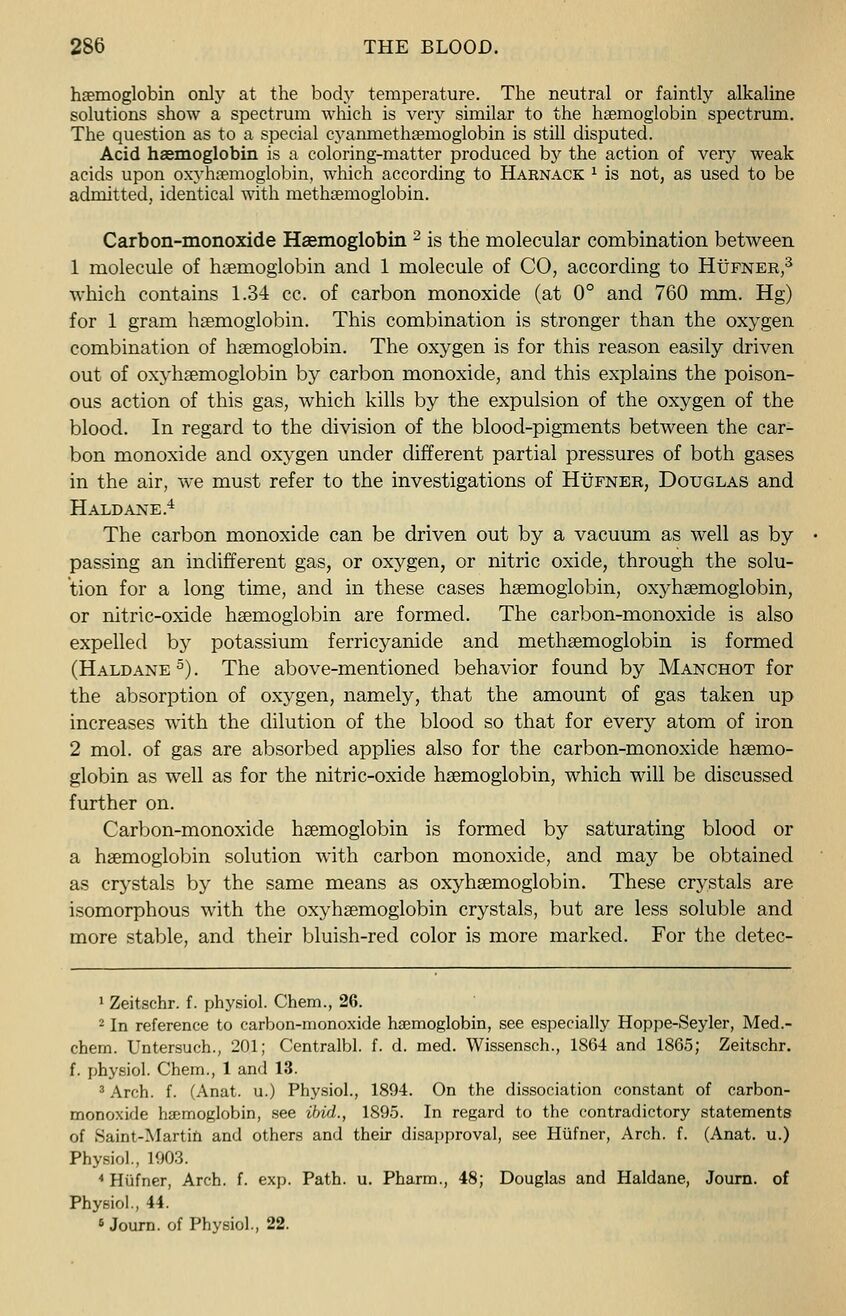
Full resolution (JPEG) - On this page / på denna sida - V. The Blood - II. The Form-elements of the Blood - Blood-pigments

<< prev. page << föreg. sida << >> nästa sida >> next page >>
Below is the raw OCR text
from the above scanned image.
Do you see an error? Proofread the page now!
Här nedan syns maskintolkade texten från faksimilbilden ovan.
Ser du något fel? Korrekturläs sidan nu!
This page has never been proofread. / Denna sida har aldrig korrekturlästs.
286 THE BLOOD.
hsemoglobin only at the body temperature. The neutral or faintly alkaline
solutions show a spectrum which is very similar to the hsemoglobin spectrum.
The question as to a special cyanmethsemoglobin is still disputed.
Acid haemoglobin is a coloring-matter produced by the action of very weak
acids upon oxyhemoglobin, which according to Harnack * is not, as used to be
admitted, identical with methsemoglobin.
Carbon-monoxide Haemoglobin 2
is the molecular combination between
1 molecule of hsemoglobin and 1 molecule of CO, according to Hufner,3
which contains 1.34 cc. of carbon monoxide (at 0° and 760 mm. Hg)
for 1 gram haemoglobin. This combination is stronger than the oxygen
combination of hsemoglobin. The oxygen is for this reason easily driven
out of oxyhsemoglobin by carbon monoxide, and this explains the poison-
ous action of this gas, which kills by the expulsion of the oxygen of the
blood. In regard to the division of the blood-pigments between the car-
bon monoxide and oxygen under different partial pressures of both gases
in the air, we must refer to the investigations of Hufner, Douglas and
Haldane.4
The carbon monoxide can be driven out by a vacuum as well as by
passing an indifferent gas, or oxygen, or nitric oxide, through the solu-
tion for a long time, and in these cases hsemoglobin, oxyhsemoglobin,
or nitric-oxide hsemoglobin are formed. The carbon-monoxide is also
expelled by potassium ferricyanide and methaemoglobin is formed
(Haldane 5
) . The above-mentioned behavior found by Manchot for
the absorption of oxygen, namely, that the amount of gas taken up
increases wr
ith the dilution of the blood so that for every atom of iron
2 mol. of gas are absorbed applies also for the carbon-monoxide hsemo-
globin as well as for the nitric-oxide hsemoglobin, which will be discussed
further on.
Carbon-monoxide hsemoglobin is formed by saturating blood or
a hsemoglobin solution with carbon monoxide, and may be obtained
as crystals by the same means as oxyhsemoglobin. These crystals are
isomorphous with the oxyhsemoglobin crystals, but are less soluble and
more stable, and their bluish-red color is more marked. For the detec-
1
Zeitschr. f. physiol. Chem., 26.
2
In reference to carbon-monoxide haemoglobin, see especially Hoppe-Seyler, Med.-
chem. Untersuch., 201; Centralbl. f. d. med. Wissensch., 1S64 and 1865; Zeitschr.
f. physiol. Chem., 1 and 13.
3
Arch. f. (Anat. u.) Physiol., 1894. On the dissociation constant of carbon-
monoxide hsemoglobin, see ibid., 1895. In regard to the contradictory statements
of Saint-Martin and others and their disapproval, see Hufner, Arch. f. (Anat. u.)
Physiol., 1903.
4
Hufner, Arch. f. exp. Path. u. Pharm., 48; Douglas and Haldane, Journ. of
Physiol., 44.
6
Journ. of Physiol., 22.
<< prev. page << föreg. sida << >> nästa sida >> next page >>